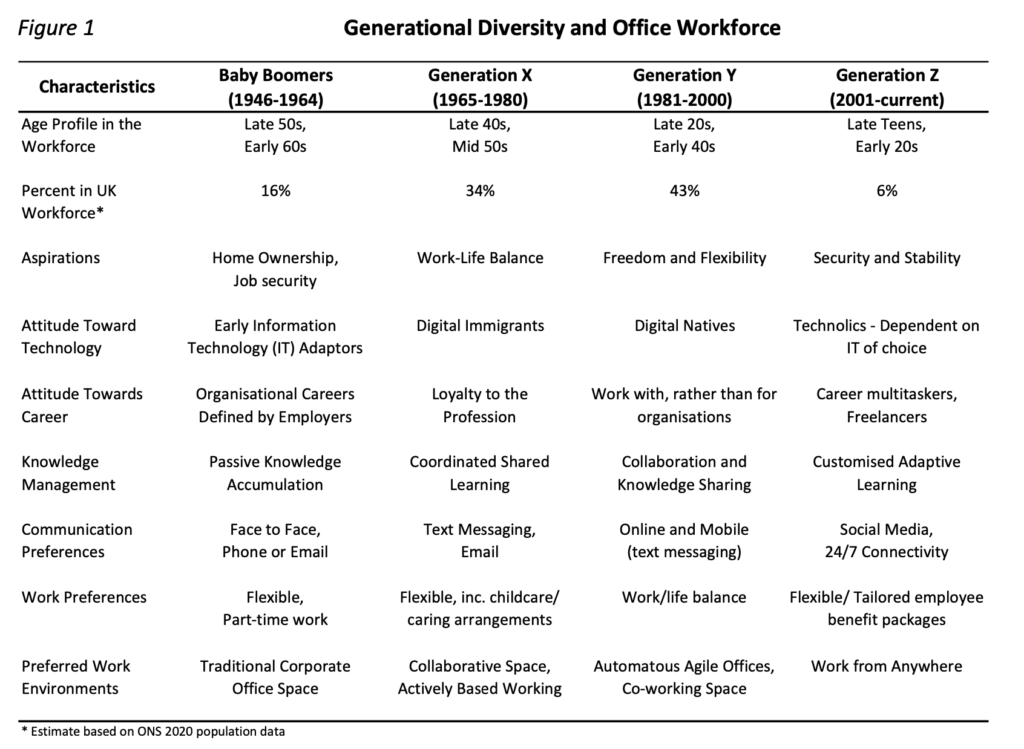In this era of major technological advancements, the Covid-19 pandemic has supercharged changes, especially in the way we communicate and work. Organisations are changing rapidly to a flexible digital office environment. While the talk is prominently about co-working space and working from home, there is a need to focus on the most expensive cost: the space user. In many organisations, it seems current strategies for office workers are linked to an approach of one space style meets everyone’s requirements.
Organisations need to understand that mono workspaces may not attract and retain valuable workers of all ages. Historical reasons for leaving a job, after salary, is often the work environment. This has been amplified by the pandemic with remote working, as many workers are now enjoying a better work/life balance with increased flexible work preferences.
In embracing flexibility, agile workplace solutions can balance the needs of the multigenerational workforce and create the desired productive benefits that are cherished by modern companies. In regional locations, for approximately every pound spent on space, £10 is spent on the employee salary. This places the corporate versus the individual demand in perspective, with the physical attributes of the workplace representing a key element of the organisational systems, processes and culture.
There are four significant generations in the workforce: Baby Boomers, Generation X, Generation Y (Millennials) and Generation Z. Figure 1 details their profiles, preferences and work motivations.

Figure 1 highlights the scale of workforce variation relative to each age group with Generation Y making up 43% of the current workforce. In part, this is due to the years which form the generations, for example: Generation X covers five less years than Generation Y. In saying that, global projections for 2025 onwards, suggest Generation Y and Z combined will represent more than 75% of the workforce. For businesses, understanding how to get the best out of these technology-savvy generations focused on multitasking which, among other points, will be critical with workplace strategies.
The differences across generations to managing digital technology advances have revealed older employees tending to be slowest to change their work habits and adapt to new, more efficient digital processes. In detailing this, it is important to recognise the breadth and depth of skills that each generation can bring to their place of work. This can offer knowledge, diverse thinking and form creative and interesting workplaces.
Interestingly, the Baby Boomers – the oldest working generation – were the first generation to have a sense of opportunity after World War II and, according to the Resolution Foundation (2019), they hold over half the country’s wealth, despite only making up around 21% of the UK population. With loyalty and job security a priority, many Boomers have been with the same employer for over 10 years and so may have a large say in an organisation’s operations. This may be challenging, as they may be the least prepared to adapt to changes and avoid conflict within a progressive work environment.
Unlike the Boomers, Generation X has experienced much more uncertainty in nearly every aspect of their life. Events like the early 1990s UK recession, 9/11 terrorist attack, Global Financial Crisis, etc, have contributed to poor job retention. This is demonstrated by the 10 largest corporate layoffs in history that have happened since 1993 (Impellam Group, 2020). Understandably, this and later generations are focused less on loyalty to an organisation and more to the profession, work/life balance and career flexibility.
In illustrating this, both the workplace and peoples’ outlooks are changing. Future projections indicate that the pace of digital change will increase and so cohesion and collaboration between age groups in the workplace will become much more important. The key will be in harnessing these skills, while building succession plans that encourage future generations to join and stay with organisations. A dynamic workplace should be an important priority for all businesses.
A talented workforce is a major attraction for organisations. Often this can be achieved by celebrating diversity of thoughts and opinions gained in many instances from life experiences. To realise this, organisations need to know about each generation’s values, workstyles and behavioural practices. Understanding the common underlying themes and preferences of each generation can provide an effective tool in creating an inclusive thriving workplace.







